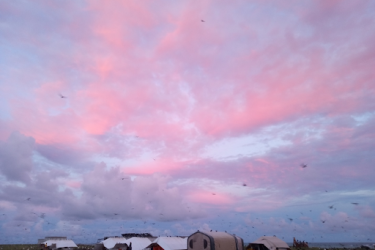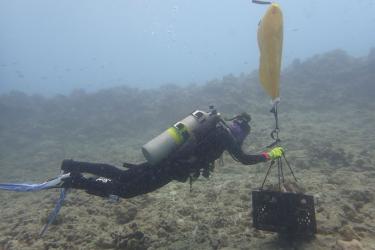Assessment and recovery camps in the Papahānaumokuākea Marine National Monument are essential to guiding the recovery of endangered Hawaiian monk seals. The completion of the 2023 camp contributes to a proud 40-year conservation science legacy. Throughout August and September, the team conducted a 28-day research mission and established short (16- to 20-day) camps at select locations throughout the monument.
During the 2023 camp, NOAA researchers and partners accomplished much in an effort to recover this endangered species, including:
- Conducting 27 Hawaiian monk seal interventions to improve seal survival
- Documenting 170 pups born in the monument
- Releasing five rehabilitated seals back into the wild
NOAA researchers share their successes and reflections from this important mission and other Hawaiian monk seal monitoring efforts over the past year.
Counting Together—and On One Another
One of the most important parts of researching any species, especially a species with low numbers, is to know exactly how many individuals exist in a population. Without a way to tell individual animals apart, this can be incredibly difficult. When monk seal pups wean from their mothers at a few weeks of age, researchers apply colored tags to their hind flippers—a very important field camp task! Once a monk seal is no longer a pup and more mobile, it is very difficult to apply flipper tags. The tags are engraved with a unique number and letter series that, along with color, can be used to identify that particular seal. Tag colors represent the place in Hawai‘i they were born.
Thanks to the ability to uniquely identify individual monk seals, NOAA researchers have estimated the population size of Hawaiian monk seals to be 1,605 (2022). Annual field camps and tagging are necessary for monitoring population estimates. The past year underscored just how important partners are to this large undertaking. The Hawai‘i Department of Land and Natural Resources, U.S. Fish and Wildlife Service, and the Papahānaumokuākea Marine Debris Project all contributed to monitoring and tagging efforts throughout the monument. The U.S. Fish and Wildlife Service rescued a seal without a clear path to the ocean due to aging infrastructure at Sand Island, Kuaihelani (Midway Atoll). The Papahānaumokuākea Marine Debris Project team even removed an eel from the nose of a monk seal pup!
Monk seal researchers from NOAA spent 2 days at Hōlanikū (Kure Atoll) to work with the volunteers and staff from the Kure Atoll Conservancy. This effort expanded partnerships and trained others in monk seal handling and tagging techniques. Hōlanikū is the oldest and westernmost island in the archipelago and represents the furthest land mass in the sacred realm of Pō. Hōlanikū is inhabited year-round and managed by the Hawai‘i Department of Land and Natural Resources. Their team conducts periodic monk seal surveys and has the potential to conduct life-saving interventions, such as disentangling seals, when our team is not present. During the short 2-day survey effort on Hōlanikū, the teams tagged 10 monk seal pups.
On Manawai (Pearl and Hermes Atoll), the team of five scientists split into two groups and established small camps at opposite ends of the atoll. Manawai is primarily underwater, with numerous islets spread across a reef area of 194,000 acres. Depending on the time of year and the tide, the 80 acres of emergent land can be found on several dynamic and ever-shifting sandy spits and a few vegetated islands. Monk seals roam throughout the atoll, whether swimming in the patchwork reef of greens and blues or clinging to an island the size of a baseball pitching mound. The divide-and-conquer approach paid off, and the team applied flipper tags to 12 pups during the 11 survey days at Manawai!
Intervening for Seal Survival
Lalo (French Frigate Shoals) is home to approximately 20 percent of the Hawaiian monk seal population, with many pups born later in the year than at other sites. Researchers need to spend more time at Lalo in order to carry out life-saving interventions on monk seals. This is due to aging infrastructure from previous military installations and high rates of Galapagos shark predation. Field teams and partners conducted 27 interventions to improve seal survival in 2023—25 of these took place at Lalo. This included:
- Translocating 22 weaned pups from historically high shark predation risk areas to Tern Island
- Rescuing two seals without a clear path to the ocean due to aging infrastructure at Tern Island
- Treating an injured juvenile female with antibiotics
Five Hawaiian monk seals were admitted to The Marine Mammal Center’s Hawaiian monk seal hospital, Ke Kai Ola, for rehabilitation in 2022 and were released back into the wild in 2023 at Lalo and Kuaihelani.
Mamas and Pups
Researchers are excited to report a record-breaking feat of monk seal motherhood! On Lalo, YC31, a 28-year-old female monk seal, gave birth to her 19th pup! She takes the lead for the most recorded births of any monk seal. Two of her daughters, YE23 and YI27, also gave birth this past year, adding two additional grandpups to her growing family tree!
Our team is hard at work analyzing the data collected in 2023 so that we can assess the population status and guide future recovery efforts. While our team continues to finalize data from the past year, preliminary results of the pup count are promising:
- 170 monk seal pups were counted in the monument; at least 159 of these pups successfully weaned
- 50 of the monk seal pups were born on Lalo
- 156 monk seal pups were tagged
Despite a shortened field season at most sites in 2023, only 10 fewer pups were documented than the previous year.
Growing in Gratitude and Guidance
The Hawaiian Monk Seal Research Program feels incredibly lucky to study these endangered animals in the sacred place of Papahānaumokuākea. During the research mission, researchers acknowledged their gratitude and respect for the special places they were allowed to work. They offered the Hawaiian chant of “E hō mai” at each new stop along the way. The chant focused their energies on the day ahead and asked for guidance from those who had walked before them.
Each monk seal pup born represents hope and promise for this once declining population to steadily recover from the brink of extinction. The 2023 research season was a resounding success thanks to the dedication and passion of our scientists and partners. We look forward to continuing to protect this precious population.
Are you interested in joining our Hawaiian monk seal or sea turtle team and studying these incredible animals? Seasonal field staff is hired through the Research Corporation of the University of Hawai‘i annually in the late fall for the upcoming spring/summer research season. Keep an eye out for opportunities to join us in the field!





